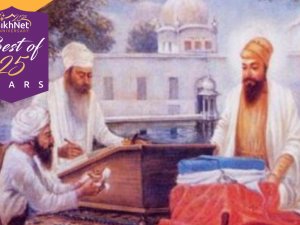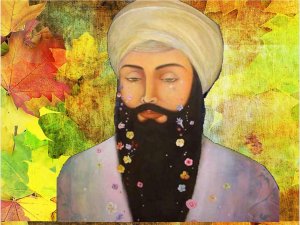| Man in Blue on Sant-Sipahi or Saint-Soldier |
|
|
548. The Sant Sipahi Sant-Sipahi or Saint-Soldier is a concept conceived by Guru Gobind Singh. Tenth Guru was not the first Guru to keep an army, and I think that for instance the armies of Guru Hargobind or Guru Har Rai were based on similar principles. When Guru Teg Bahadur went to Delhi to ask Mughal Emperor Aurangzeb to grant religious freedom to the Kashmiri Pandits his four companions were tortured and murdered and the Guru Sahib was beheaded. That demonstrated to Guru Gobind Rai that it was impossible to negotiate with Aurengzeb. He felt that Sikhs had to stand up for the right to be different and that due to the emperor's bigotry they had to use the sword. But using violence is dangerous. There are plenty examples of historical and modern movements which were forced to use violence against dictators, but who ended up losing sight of the ideals they started out with. They became warriors and oppressors like the rulers they fought against. This is the context in which I understand the Sant-Sipahi. Guru Teg Bahadur tried the peaceful way and that did not work. Guru Gobind Singh felt forced to use the sword, but he wanted his soldiers to remain faithful to the Sikh ethical principles. Saint-Soldiers should first look for a peaceful solution but when that is not possible armed struggle is justified. The Saint-Soldier should remember God with everything he/she does, should not fight out of anger or because of wanting to take what does not belong to him/her. The Guru's principles worked for his army. How well the principles were maintained in the period between the Guru's death until the advent of Maharaja Ranjit Singh is another matter. There are stories from that period about Sikhs who did not fight out of anger or greed. But there are also stories that show the opposite, like Misl fighting Misl over the land that was under their protection. And it is obvious that Maharaja Ranjit Singh, who took over the areas protected by other misls, who was greedy for costly jewels, costly horses and costly women, was not a Sant-Sipahi. That does not mean that he was all bad, but his professional army was not an organisation that a Sant-Sipahi could feel at home in. Most of the Misl soldiers that he inherited despised him, but in spite of that they were the ones who during the Anglo-Sikh wars remained loyal to the Lahore Kingdom and gave the British army a very hard time. Many of the people connected to the Lahore darbar betrayed the kingdom to the British. Since then many Sikhs have served in the British Indian Army and fought in both World Wars. The British saw the Sikhs as a 'martial race'. But is being 'martial' enough to be a Sant-Sipahi ? There are also many Sikhs who only do the Sant bit, not the Sipahi, which is not what the Guru wants from us. Guru's teachings are not difficult to understand, but practising them is challenging. |






